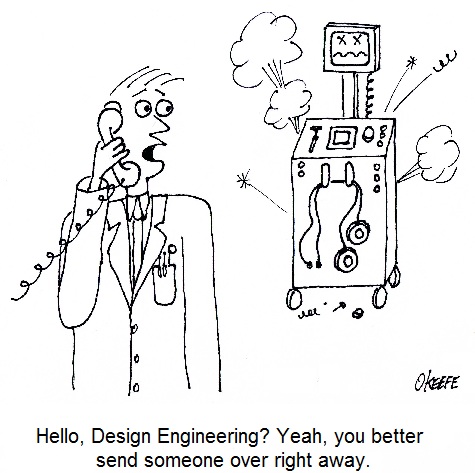| Last time we began our discussion on Preproduction, the final aspect of the Development stage of our systems engineering approach to medical device design. This is the point at which a small amount of devices are put into actual production, then evaluated for full production possibility. It is also the final juncture at which problems will be evaluated and corrected before full commercial production can begin.
Once the medical devices produced during Preproduction are assembled, they’re subjected to rigorous testing in both a laboratory and the field. This testing is necessary to see if stakeholder requirements are satisfied. At this stage devices constructed en masse on the factory assembly line are compared to prototypes built by hand by design engineers earlier in the Development stage. During Preproduction laboratory test data is gathered and analyzed by engineers to assess how the device will hold up during actual use. Real-life conditions are simulated in the lab environment to facilitate this process. For example, lab testing of a Preproduction kidney dialysis machine can determine whether its blood pump flow rate falls within acceptable range during hundreds of hours of operation. Other factors, such as durability of materials are evaluated during lab testing. In the case of the dialysis machine, there is a component called a dialyzer that filters toxic waste from blood. Over the duration of the lab test, the material used in the dialyzer filter membranes would be inspected and evaluated for durability. Next week we’ll conclude our discussion on Preproduction to see what happens when testing is moved outside the lab environment into the field. ___________________________________________ |
Posts Tagged ‘maintenance instructions’
Systems Engineering In Medical Device Design – Preproduction, Part 2
Monday, February 11th, 2013Tags: design engineer, design revision, Development Stage, durability of materials, engineering expert witness, factory assembly line, field testing, filter, filter membrane, flow rate, forensic engineer, lab testing, machine, maintenance instructions, manufacturing, medical device design, operating instructions, preproduction medical device, Production Stage, project stakeholder, pump, systems engineering in medical device design, test data, Utilization Stage
Posted in Engineering and Science, Expert Witness, Forensic Engineering, Innovation and Intellectual Property, Personal Injury, Product Liability | Comments Off on Systems Engineering In Medical Device Design – Preproduction, Part 2
Systems Engineering In Medical Device Design – Instructions, Part 4
Sunday, January 27th, 2013| Last time we wrapped up our discussion on the development of quality control instructions for use during the Development stage of the systems engineering approach to medical device design. These instructions are used to guide quality control inspection and testing during the Production stage. Now let’s continue our discussion on the development of instructions for the Utilization stage, the stage when the medical device is actually put into operation by the end user.
In the systems engineering approach to medical device design, design engineers must work closely with technical writers, those responsible for writing operating and product service instructions. The objective here is to share the engineering staff’s intimate knowledge of the medical device’s design with the writers in order to ensure that instructions are clearly written, comprehensive, and follow a logical progression. Instructions must be written so as to be easily understood by lay people outside of the engineering profession and medical device industry, because most of the individuals using the device will be healthcare professionals and service technicians, individuals lacking a background in engineering or medical device development. Instructions are not only meant for the eyes of end users. They are also subject to review by governmental agencies. This fact acts as a safeguard to ensure device compliance both with regulatory requirements and industry standards as regards cautions and warnings. For example, instructions may be required to caution the user to allow the device to warm up for a certain period of time before use to avoid patient discomfort when coming into contact with cold metal. Instructions might also warn against a harmful interaction if the device is used in conjunction with other devices. For example, an electronic muscle stimulator may send electrical pulses into a patient’s body that can interfere with the operation of their heart pacemaker. No doubt this is something that the operator of the device and the patient would want to be informed of. At this point our medical device design has been completed, and instructions and procedures written, but the Development stage is not yet complete. Next time we’ll continue our discussion on this stage to see how a systems engineering step helps us to be safe rather than sorry after full production of the device has begun. ___________________________________________ |
Tags: design engineers, Development Stage, engineering expert witness, forensic engineer, harmful interaction, heart pacemaker, maintenance instructions, medical device design, medical device industry, muscle stimulator, operating instructions, Production Stage, quality control inspection, quality control testing, regulations, service instructions, systems engineering approach, technical writer, Utilization Stage
Posted in Engineering and Science, Expert Witness, Forensic Engineering, Innovation and Intellectual Property, Personal Injury, Product Liability, Professional Malpractice | Comments Off on Systems Engineering In Medical Device Design – Instructions, Part 4





